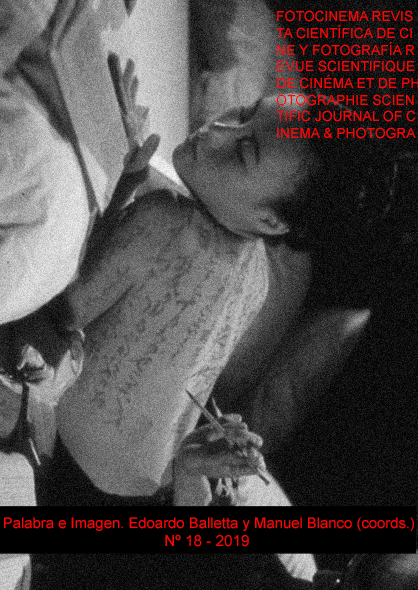From the photographic to contemporary photograpy: The image in the discursive interchange
DOI:
https://doi.org/10.24310/Fotocinema.2019.v0i18.5532Keywords:
Photography, Postphotography, New media, Digital cultureAbstract
In this article, we shall reflect on the changes in the ways of production, circulation and reception of photography since the emergence of the digital technologies and the new Internet-based media. With respect to this, we shall reflect on the impact that the new technologies caused in the way of thinking about photography (change from analogical to digital) and its social uses (from the dematerialization of the image and the new digital media). Transformations that towards the change of the century led to the diagnosis of death of photography and the arrival of a new age: the post-photography age, in the context of a new visual digital culture.
Nowadays, photography is not only a way of testimony and memory (these were its fundamental functions during the 20th century) but it also gains a new first-rate communicative function. Shared, commented and interchanged, contemporary photography is a message in itself in the daily discursive interchange.Downloads
Metrics
References
Aguilar, G. (2015) Más allá del pueblo: imágenes, indicios y políticas del cine. Buenos Aires: Fondo de Cultura Económica.
Baudrillard, J. (2001) La precisión de los simulacros (1983). WALLIS, B. (Comp.) Arte después de la modernidad. Nuevos planteamientos en torno a la representación. Madrid: Akal.
Barthes, R. (2005) La cámara lúcida. Buenos Aires: Paidós.
Bazin, A. (2004) Ontología de la imagen fotográfica. ¿Qué es el cine? Madrid: Rialp.
Berger, J. (1998) Apariencias. Berger, J. y Mohr, J. (1998) Otra manera de contar. Murcia: Editorial Mestizo.
Carlón, M. (2015) Público, privado e íntimo: el caso chicas bondi y el conflicto entre derecho a la imagen y la libertad de expresión en la circulación contemporánea. Castro, P. (Ed.) Dicotomía público/privado: estamos no camino certo? Maceió: EDUFAL.
Carlón, M. (2016) Registrar, subir, comentar, compartir: prácticas fotográficas en la era contemporánea. Corro, P. y Robles, C. (Eds.) Estética, medios y subjetividades. Santiago: Universidad Pontificia Católica de Chile.
Carlón, M. (2012) En el ojo de la convergencia. Los discursos de los usuarios de Facebook durante la transmisión televisiva de la votación de la ley de matrimonio igualitario. Carlón, M. y Fausto Neto, A. (Comp.) La Política de los internautas. Buenos Aires: La Crujía.
Carlón, M. (2014) ¿Del arte contemporáneo a una era contemporánea? Rovetto, F. y Reviglio, M. (comp.) Estado actual de las investigaciones sobre mediatizaciones. Centro de Investigaciones sobre mediatizaciones UNR. Rosario: UNR Editora. Disponible en: http://www.cim.unr.edu.ar/archivos/cuadernodelcim2.pdf (última consulta: 18/8/2016).
Carlón, M.y SCOLARI, C. (Eds) (2009). El fin de los medios masivos. Buenos Aires: La Crujía.
Concha, J. (2011) La desmaterialización fotográfica. Santiago de Chile: Edición Metales Pesados.
Dubois, P. (2008) El acto fotográfico y otros ensayos. Buenos Aires: La Marca.
Fontcuberta, J. (2007) El Beso de Judas. Fotografía y Verdad. Barcelona: Gustavo Gili.
Fontcuberta, J. (2012) La cámara de pandora. La fotografía después de la fotografía. Barcelona: Gustavo Gili.
Fontcuberta, J. (2016) La furia de las imágenes. Notas sobre la postfotografía. Barcelona: Galaxia Gutenberg.
Krauss, R. (2002) Lo fotográfico por una teoría de los desplazamientos. Barcelona: Gustavo Gili.
Lister, M. (Comp.) (1997) La imagen fotográfica en la cultura digital. Barcelona: Paidós.
Mirzoeff, N. (2003) Una introducción a la cultura visual. Barcelona: Paidós.
Mitchell, W. (1992) Thereconfiguredeyes: visual truth in the post-photographic era. Cambridge: MassMitPress.
Peirce, C. (1987) Obra lógico semiótica. Madrid: Taurus.
Ritchin, F. (2010) AfterPhotography. WW Norton & Co.
Robins, K. (1997) ¿Nos seguirá conmoviendo una fotografía? en Lister, M. (Comp.) La imagen fotográfica en La cultura digital. Barcelona: Paidós.
Schaeffer, J. (1990) La imagen precaria. Del dispositivo fotográfico. Cátedra: Madrid.
Sontag, S. (1977) Sobre la fotografía. Buenos Aires: Alfaguara.
Verón, E. (1997) De la imagen semiológica a las discursividades. El tiempo de una fotografía. Veyrat-Masson, I. y Dayan, D. (Ed.) Espacios públicos en imágenes. Barcelona: Gedisa.
Verón, E. (2013) La semiosis social, 2: ideas, momentos, interpretantes. Buenos Aires: Paidós.
Downloads
Published
How to Cite
Issue
Section
License
All contents published in Fotocinema Revista científica de cine y fotografía are protected under the Creative Commons Attribution-NonCommercial-ShareAlike 4.0 International (CC BY-NC-SA 4.0) license. All about this license is available in the following link: <http://creativecommons.org/licenses/by-nc-sa/4.0>
Users can copy, use, redistribute, share and exhibit publicly as long as:
- The original source and authorship of the material are cited (Journal, Publisher and URL of the work).
- It is not used for comercial purposes.
- The existence of the license and its especifications are mentioned.
There are two sets of authors’ rights: moral and property rights. Moral rights are perpetual prerogatives, unrenounceable, not-transferable, unalienable, imprescriptible and inembargable. According to authors’ rights legislation, Fotocinema. Revista científica de cine y fotografía recognizes and respects authors moral rights, as well as the ownership of property rights, which will be transferred to University of Malaga in open access. The property rights are referred to the benefits that are gained by the use or the dissemination of works. Fotocinema. Revista científica de cine y fotografía is published in an open access form and it is exclusively licenced by any means for doing or authorising distribution, dissemination, reproduction, , adaptation, translation or arrangement of works.
Authors are responsable for obtaining the necessary permission to use copyrighted images.













13.png)




